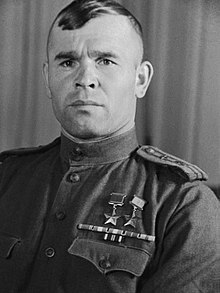Arseni Wassiljewitsch Vorosheikin

Arseniy Vorozheykin ( Russian Арсений Васильевич Ворожейкин * October 15 . Jul / 28. October 1912 greg. In Prokofjewo ( province Nizhny Novgorod ); † 23. May 2001 ) was a Soviet pilot and two-time Hero of the Soviet Union .
Life
Vorosheikin served in the Red Army from 1931 to 1932 and then joined the Communist Party . From 1934 to 1937 he trained as a military aviator and was transferred to a fighter squadron as a political commissioner .
In 1939 he took part in combat operations for the first time during the border disputes on Chalchin Gol and was able to shoot down six Japanese aircraft in 30 missions with his type I-16 . During one operation, Vorosheikin himself was shot down by I-97 fighters . Although he succeeded in an emergency landing, his plane overturned and he suffered a compression fracture on his spine. After his recovery, he still continued his aviation career, even if his injury repeatedly caused difficulties for him in the course of it. He was also used in the Finnish-Soviet winter war , but did not score any kills there.
After the attack on the Soviet Union , he served alternately in the Kalininer , Voronezh and 1st Ukrainian Front from August 1942 . During the Battle of Kursk he flew a Jak-7B within the 728th Fighter Regiment and shot down nine aircraft between July 14 and August 4, 1943. On February 4, 1944, Vorosheikin was appointed Hero of the Soviet Union and squadron commander of the 728th IAP after 78 front-line flights and 32 air battles, while being promoted to captain. By then, he had 19 confirmed kills. He received the award for the second time on August 19, 1944 after 300 front-line flights, 90 air battles and 52 kills. Vorosheikin became deputy commander of the 32nd Guards Fighter Regiment.
From October 1944 he was recalled from the front and used as an instructor. Vorosheikin was known to hit from a very short distance and if possible with the first burst. He tried to pass these combat tactics on to his subordinate young pilots during his training. He experienced the end of the war as a major and then took over command of various aviation units before he graduated from the General Staff Academy in 1952 and became deputy commander of the air defense of the Black Sea Fleet. 1957 Vorosheikin was recalled to the reserve in the rank of major general of the aviators.
Vorosheikin was four times bearer of the Order of the Red Banner and the Order of Lenin . He published several books about his war experiences, of which "Jagdflieger" was translated into German.
literature
- A. W. Voroscheikin: Fighter Pilot Volume 1 . Military Publishing House of the GDR , Berlin 1976 (Russian: Истребители . Translated by Arno Specht).
- A. W. Voroscheikin: Fighter Pilot Volume 2 . Military publishing house of the GDR , Berlin 1976 (Russian: Над курской дугой (Over the Kursk Arch) / Рассвет над киевом (Dawn over Kiev) . Translated by Heinz Kübart / Hans-Joachim Lambrecht).
- Wilfried Copenhagen : Lexicon Soviet Aviation. Elbe – Dnjepr, Klitzschen 2007, ISBN 978-3-933395-90-0 .
Web links
Individual evidence
- ↑ Arseni Voroscheikin: Fighter Pilot Volume 1 . Military publishing house of the GDR. Berlin, 1976. pp. 118-145.
- ^ Rainer Göpfert / Rolf Jakob: The Finnish Winter War , Flieger Revue Extra No. 11, 2005, p. 45.
- ↑ Christopher Shores: Decisive air battles of the 2nd World War. Engine book. Stuttgart, 1988. ISBN 3-613-01240-5 . P. 163.
| personal data | |
|---|---|
| SURNAME | Vorosheikin, Arseni Wassiljewitsch |
| ALTERNATIVE NAMES | Voroshejkin |
| BRIEF DESCRIPTION | soviet pilot |
| DATE OF BIRTH | October 28, 1912 |
| PLACE OF BIRTH | Prokofiev |
| DATE OF DEATH | May 23, 2001 |
